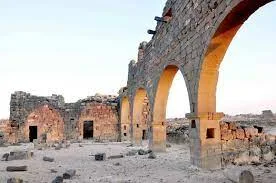“Umm al-Jamal” in Jordan: a “black oasis” full of cultural heritage
As a black oasis studded with basalt stones, the ancient city of Umm al-Jimal in Jordan attracts thousands of tourists annually, as it is a historical site that smells of cultural and civilizational heritage.
The archaeological "Umm al-Jamal" is located 86 kilometers from the capital Amman, and to the east of the desert of Mafraq Governorate (northeast) near the Syrian border, with a total area of about 5 square kilometers.
The historical city is characterized by its black basalt stones, dating back to the Roman-Byzantine Nabataean era, as it is one of the oldest historical sites in Jordan, which has been preceded by centuries of civilizations.
The city of Umm al-Jamal is known as the “Black Oasis” due to the color of its volcanic rocks. It is also characterized by the abundance of camels (camels) and is also an active site for archaeological research and cultural heritage.
The history of the buildings in the ancient city goes back more than 2000 years, when the Nabataeans, Romans, Byzantines, Umayyads and Abbasids settled in it.
The city was historically famous for being a crossroads of the roads that linked Palestine and Jordan with Syria and Iraq, as it is a station in the middle of the Trajan Road linking Amman and Basra or Damascus and Basra.
With Nabataean, Greek, Latin and Arabic inscriptions, the city of Umm al-Jimal is in the middle of 3 valleys extending from the southern slopes to Jabal al-Arab, and includes a temple, 17 churches, 3 mosques, 33 ponds and a water tank.
Historical studies indicate that Umm al-Jimal was subjected to a devastating earthquake in 749 AD, which led to the destruction of most of its buildings, but the Umayyads reconstructed large parts of it, and restoration work is still ongoing, through government projects with Jordanian and foreign experts. The archaeological city includes exceptional religious sites, most notably the “Julianos” Church, which is the oldest church in the region, and contains two Arab inscriptions dating back to the pre-Islamic period.
Najd Mazahreh, the supervisor of the General Department of Antiquities in Jordan (governmental) said that the first Arabic inscription was written in the Syriac language, and it says, "This inscription is a commemoration of Fihr bin Sali, who was a teacher of Jesima, King of Tanukh," one of the Ghassanid kingdoms whom Queen Zenobia fought when She came from Palmyra to avenge her husband.
As for the second Arabic inscription, it is a witness to a tomb written in Kufic script without dotting, and it says: “God forgive Aliyeh bin Ubaidah, the scribe of slaves, the highest of Bani Omri, and those who read it should be aware of it.”
Mazahreh added that the city of Umm al-Jamal contains a military barracks and churches dating back to the Byzantine era, a water tank and about 33 pools, dating back to the Roman and Nabatean eras, in addition to a court, walls, and the Commodus Gate (Roman Emperor).
She added that the city attracts thousands of tourists from all over the world annually; The Jordanian authorities are also seeking to include it in the World Heritage List; Because of its archaeological and historical value.
She pointed out that the Jordanian Ministry of Tourism added a museum inside the rooms of the Umayyad House, which contains valuable items that were found through excavations in the 1960s.
The Jordanian Mafraq Governorate (northeast) includes 14 archaeological sites, in addition to dozens of other sites that have been documented, after conducting archaeological surveys.
According to official statistics, Jordan includes about 100,000 archaeological and tourist sites, distributed in 12 governorates in the country.


